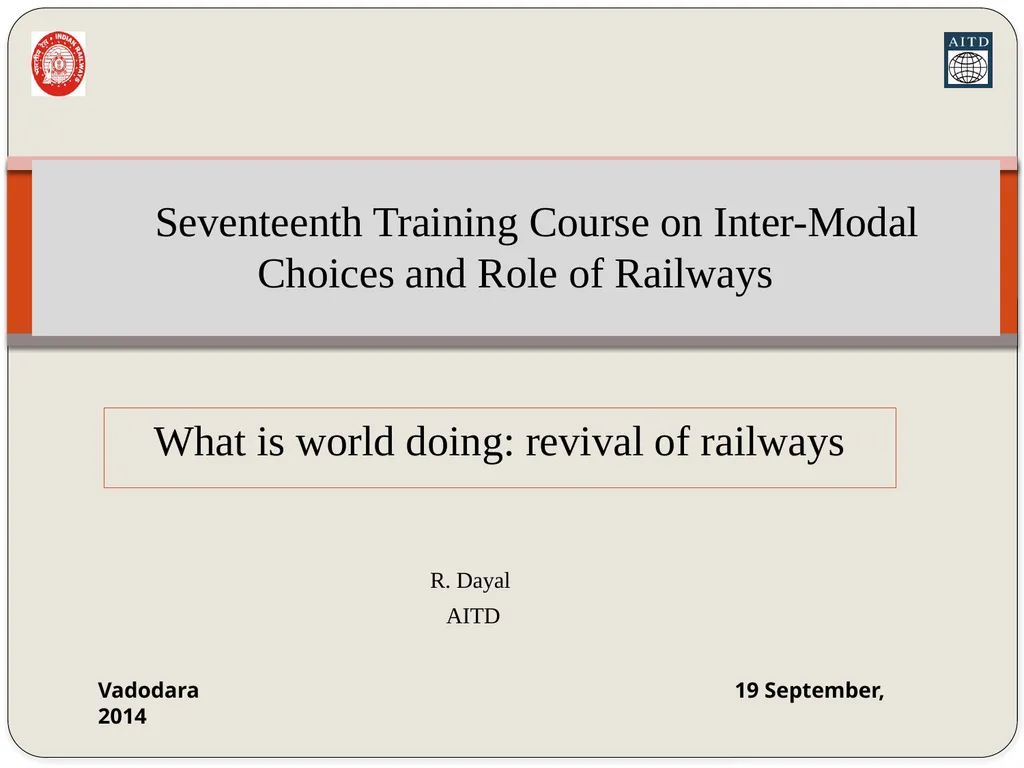R. Dayal AITD Seventeenth Training Course on
Author : conchita-marotz | Published Date : 2025-05-10
Description: R Dayal AITD Seventeenth Training Course on InterModal Choices and Role of Railways Vadodara 19 September 2014 What is world doing revival of railways Railways changed the world later lost the plot Railways changed the world later
Presentation Embed Code
Download Presentation
Download
Presentation The PPT/PDF document
"R. Dayal AITD Seventeenth Training Course on" is the property of its rightful owner.
Permission is granted to download and print the materials on this website for personal, non-commercial use only,
and to display it on your personal computer provided you do not modify the materials and that you retain all
copyright notices contained in the materials. By downloading content from our website, you accept the terms of
this agreement.
Transcript:R. Dayal AITD Seventeenth Training Course on:
R. Dayal AITD Seventeenth Training Course on Inter-Modal Choices and Role of Railways Vadodara 19 September, 2014 What is world doing: revival of railways Railways changed the world, later lost the plot Railways changed the world, later lost the plot In 1829, came the rail-road – a product truly without precedent. It forever changed economy, society and politics; it rapidly changed the “mental geography.” The steam engine was to the first industrial revolution what the computer has been to the information revolution. Recent history’s most important change-agent, railways over time failed to adapt and grow. Railways can ill afford to remain a mere railway system. It’s a transport system. No, it’s much more. Its remit is to be an integrated logistics solution provider. Rail came….. with revolutionary impact Mechanised rail system first appeared in England during 1820s, spread across Europe soon with England alone having 10,433 miles of track in 1860. As the only mode of transport with characteristics of heavy haul over long distances, railways started a promising journey. The share of railways became much more than road in both passenger mobility and freight movement. But soon, road transport outpaced rail transport during the second half of the 20th century. Rail history….. rise , fall and rise Source: SCI Verkehr Gmbh In global terms, the public railway network consists of nearly a million route-km. Compared to population, rail network length per capita in developing countries is only a fifth of that in developed countries. Nearly two-thirds of world’s all rail freight is carried in developing countries; over three quarters of that is carried in three countries-China, India and the Russian Federation. Over the latter 20th and now 21st century, rail has seen a gradual decrease in both freight and passenger traffic. Global rail network…..a perspective Freight modal split:(%) Source: International Transport Forum, Transport Outlook, 2011 Modal share in passenger traffic:(%) Source: International Transport Forum, Transport Outlook, 2011 Railways – no mere rail mode It needed to play a lead role in transport domain Today, it needs to be an important partner in integrated logistics solution system Change looms large: dominant characteristics Demographics: Globally, population is still growing; we are living longer. Three billion humans lived on the planet in 1960. In 2050, world population could reach 9 billion. Urbanisation: 70% of world’s population will be in cities by 2050. The 40 largest mega regions account for two-thirds of globe’s














